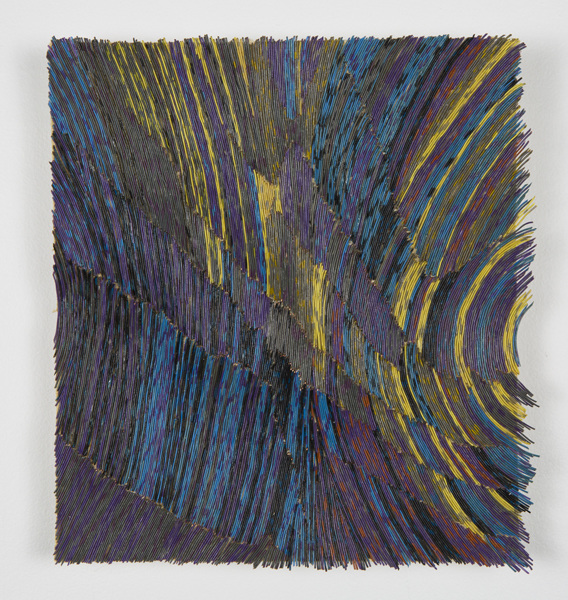Exhibition Statement for The Bakery gallery
Emily Hermant is an interdisciplinary artist whose sculptures, drawings, and installations explore themes of communication, gendered labor, and the spatial experiences of the body. She received her BFA in Studio Arts from Concordia University in Montreal, QC, Canada, and her MFA as a Trustee Merit Scholar in Fiber & Material Studies from the School of the Art Institute of Chicago.
Her work has been exhibited in museums, galleries, and festivals in Canada, the United States, South America, and Europe, and has been featured in LVL3 Media, ArtSlant, Espace Sculpture, The Washington Post, and TimeOut Chicago, among others. Hermant has been awarded grants from the Canada Council for the Arts and the Conseil des Arts et Lettres du Quebec, and artist residencies at Haystack, ACRE, Ox-Bow School of Art, The Ragdale Foundation, Nordic Artists Centre, and the Vermont Studio Center. Hermant is currently based in Vancouver, BC, where she is an Assistant Professor of Sculpture + Expanded Practices in the Audain Faculty of Art at Emily Carr University of Art + Design.
Surface and texture are fundamental elements in Hermant’s work. Her pieces communicate via materials that are layered, bent, or constructed. An accumulation, or slow build-up of materials, creates a pattern or surface texture. Her piece Thumbpins—an older work from 2007— arranges 70,000 dressmaker pins to whorl a thumbprint on the gallery wall. These pins are integral to the work of a dressmaker, but unseen and perhaps unappreciated by a consumer of the dress. Hermant utilizes unseen everyday objects, recast from their original roles, as components of large, complicated systems that create unique textures to communicate ideas.
The viewer enters the idea through the texture. From a distance, an image is recognized without the material being detected. Nearer to the piece, the viewer separates the layered components that create texture and image. Hermant takes a single material and repeats it over and over again to render an image, pattern, or texture. The object, or material, then breaks apart to create a bigger image. The communication of the work happens through repetition and tactility – an intense build-up of surface. This labour is a way of knowing and form of knowledge that guides her through the act of making.
The repetition of small, simple materials creates large, complicated images. Mirroring that, the material itself – such as dressmaker pins or telecommunications wires – are small components that support the creation of integrated and complex systems, such as: a tailored garment or wi-fi network. The materials she selects are intentionally ordinary – they’re everyday objects used readily, but their unique labour isn’t realized until viewed in a different context.
The pieces in the show, Reflections on Perseid (No.1), Reflections on Perseid (No. 2), and Reflections on Perseid (No. 3) are all constructed from cut and rearranged telecommunications wires, an invisible aspect of our current landscape and ecosphere. Hermant had been searching for concrete methods for mapping out wi-fi patterns, signals, and other elements of the invisible clouds of information that surround us. What would they look like if the world paused and the information was given colour and a body? Their new iteration is bright and physically dynamic. Telecommunication wires are thrown out in mass quantities. The scale of electronic waste is staggering. Hermant salvages digital debris from junkyards, hauling wires coiled in huge bundles and stacked in baskets. Transmission systems and communications systems exist in a virtual world, but remain grounded in physical infrastructure, providing the concept that links the body of work.
The largest piece in the show, Reflections on Perseid (No. 3) has an intricate level of detail that registers differently, depending on the distance of the viewer. From afar, it’s a very different image; as the viewer approaches, the images break apart and the slips between the rows and layers of wires become visible. The ends of the copper wiring mimic the glint of starlight or constellations. All the pieces emerge from mapping the shifting patterns of light and space with an attention to layers of interruption. The interruptions, or glitches, become both surface and structure to the work.
Hermant is continuously inspired by textile artists who pushed what textile art could be and by post-war women sculptors working with abstraction. Beginning in the 1940s/1950s, with Anni Albers, Gunta Stölzl, and the movement of the Bauhaus weavers, to The Art Fabric movement of the mid-1960’s with artists like Magdalena Abakanowicz, to post-minimalist artists like Jackie Winsor, up to 1970s West Coast feminist work with artists like Senga Nengudi. Hermant continues to resonate with spatially-oriented fibre artists and process-oriented sculptors from these periods who developed radical new concepts of sculpture.
The process in Hermant’s work involves intense repetition and long periods of time, but both are necessary labours for the work to be realized The tension between resisting the intense level of concentration and the necessity of making the work drives her practice. This way of making, like stitching or embroidery, doesn’t require a single stitch – five hundred stitches create progress. The repetition is a necessity for the making. An idea may demand a certain material or a material may crystallize an idea. Inspiration runs on a spectrum. Sometimes, Hermant discovers a material and its history interests her – how does it behave? How does it misbehave? What happens when it’s manipulated this or that way? Ideas are generated from play. In other cases, the concept comes first.
Materials cut from everyday use lose their original purpose and power. In their former life, they existed with the responsibility to undertake a form of labour or carry specific shards of information. Materials removed from their intended spaces and layered or arranged in different ways may not transmit the way they used to, but they continue to carry data. In this way, Hermant moulds communication, weaving the history of a material’s use with the ingenuity of a new pattern to create complex textures of information.
